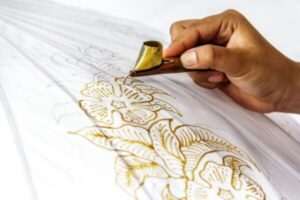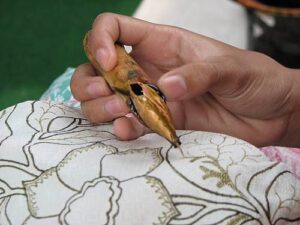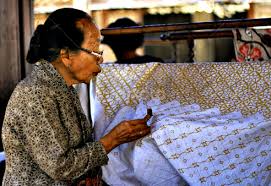Batik Printing
Batik Print is an ancient form of handloom and fabric printing. In Batik Printing on fabric, the fabric is printed with wax resist before being dyed. Due to its striking and delicate motifs, Batik Print was once considered an art of sophistication and cultivation. Batik Print encompasses a three-dimensional feature with depth and texture.
Batik prints are not only used in various types of clothes like shirts, scarves, sarees, and dresses but it is also used for furniture, pictures, and wall hangings. Batik Prints is a labor-demanding art that demands procedures to produce gorgeous and distinctive patterns on fabrics such as cotton as well as silk.
Batik Printing history
There are differences in the Batik Prints’ origins. Some say that Batik printing was carried out at Kachchh during the time of Ramayana by seasoned master artisans. Others believe that Batik Prints has its origins in Medieval Egypt and later shifted to Asian Countries as its key manufacturing centers. Some even believed that Batik Prints originated in Sumeria.
The word ‘Batik’ is derived from the Indonesian word ‘Ambatik’ which means ‘Wax writing.’ Batik Prints is a 3000-year-old art form now predominantly practiced in Indonesia, Malaysia, Japan, and India. Some other countries where Batik Print is practiced are Iran, Bangladesh, Sri Lanka, Thailand, and other regions in Africa like Nigeria, Cameroon, and Mali.
In Indonesia, only the members of the royal family utilized Batik Block prints in the old days. The crew of Malaysian national airlines wears Batik uniforms. Batik clothes are a popular souvenir in Malaysia and are popular for their Vivid colors. Java in Indonesia is popular for its exotic Batik printed motifs.
The popularity of Batik Prints can be gauged by the fact that it is adopted as a subject at Shantiniketan University in Kolkata.

Batik Printing in India
Today, Munda and Mandvi in Gujarat Kutch district are the main Centers of Batik Prints. Shantiniketan in West Bengal is the hub of Batik Prints. The uniqueness of Batik printing designs is preserved at Visva-Bharati University in West Bengal, an institution founded by Nobel Laureate Rabindranath Tagore. The University has also started a comprehensive two-year certificate course in Batik Prints for the students.
Cholamandal Artists Village, which was established in 1966 is another center of Batik Prints. In fact, it is the largest artist commune in India. It is situated in Injambakkam, Tamil Nadu. Batik Prints is also popular in Indore, Madhya Pradesh.
Batik Print Process

The wax is first applied over the penciled-in outline of the pattern. The original cloth is always white or beige. The cloth is dyed in the first bath in Indigo Blue. The area of the cloth where the wax was applied will remain white. Then the second application of wax is applied. In this case, it is a dark brown color. The poorer quality wax is used to cover the larger areas of the cloth. The darker areas help to differentiate it from the first wax applied. Any parts that are covered with this wax application will remain the indigo color.
The cloth is dyed in the second dye bath. In this case, it is navy blue. And areas that are not covered by wax will become dark blue. All the wax that has been applied thus far is removed. This is done by heating the wax and scraping it off and also by applying hot water and sponging off the remaining wax.
Wax is applied in the area of the fabric that the artist wishes to retain the indigo-blue color. Wax is applied to the area of the fabric that the artist wishes to remain white.
The fabric is submerged in the final dye bath. In this case, it is brown. Any areas of the cloth that have not been covered with wax will become brown. The finished cloth after all of the wax has been removed.
Batik Print Motifs
Batik Block printing pictures are generally composed of flower motifs, twining plants, leaves and buds, birds, butterflies, fish, geometric forms and patterns, small animals, and insects. The innovations in batik patterns are endless, as there are nearly 3,000 varieties on record. The Batik Printed motifs are broadly divided into two categories
- Geometrical
- Elaborate
The Uniqueness Of Batik Prints
The fashion and upholstery industries are utilizing batik patterns now more than ever. They’re popping up all over the runways, shopping centers, and furniture showrooms. The urban fashion industry is embracing the tradition by manufacturing sarongs, scarves, dresses, jackets, Sarees, and accessories for the ready-to-wear market. This facet of the industry focuses on the West African, Middle Eastern, and Native American batik traditions. These cultures influenced mainstream batik printing, as well as inventing new styles.
Each Batik printed piece is provided with a unique pattern or design as each region draws heavily on local religion and culture.
The Middle Eastern population often favored patterns that were based on the patola designs from India, as well as designs that featured the color green. Historically, green was a sacred color in the Muslim faith. The introduction of Islam to this area also affected batik printing in that the Islamic faith forbade the depiction of life-like pictures; this prompted the use of stylized patterns without representation of human or animal forms. They generally printed their batik designs on cotton, voile, or silk, much like traditional batik printing is done.

West African and Native American batik prints often depict the activities of people interacting in daily life. The patterns show people grinding corn, carrying water or firewood, braiding hair, dancing in ceremonies, praying for rain, or showing caricatures of emotions. Many of their batik patterns are printed on Kente cloth or mud-cloth, cotton, or voile. These cultures brought the use of new fabrics to the forefront of the batik revolution.
The Middle Eastern, West African, and Native American cultures popularized these traditional patterns through clothing beginning in the late 1960s. The upholstery and furnishings industry became familiar with the batik tradition much earlier, yet prominence did not come until the early 1950s; its popularity has yet to decrease. Several different cultures have influenced the patterns and designs of this facet of the industry.
The Chinese contribution to the batik design is most evident in the addition of more flower and bird motifs, border patterns, and incorporation of the use of pinks, yellows, and blues.
Dutch and Eurasian women have favored the use of European floral bouquets, birds, bees, trees, and butterflies in their patterns, a trend that is one of the most popular in use today. All three cultures influenced the design and color combinations so heavily, that batik is often associated with their influential characteristics.
Batik prints are so common in our society today, that it’s hard to imagine a life without their beauty. Batik prints are in our art, on our loveseats, and on our wardrobes. They’re hanging over our bay windows, and adorning our walls with their elegance. Batik printing patterns and designs have enriched many facets of an artistic heritage that encompasses many regions of the world.
Conclusion
Today, traditional and contemporary batik are equally adored by the East and West. A tradition that started 3,000 years ago has evolved into a world-renowned practice. The beauty of this tradition was helped by Fashion and furnishing to worldwide prominence. Batik Print apparel was formerly the clothing of aristocracy; Batik Print is now the art of the world.
To read about more traditional printing techniques like block printing art, click on the hyperlink, or if you looking forward to buying wooden printing blocks for your batik printing project.
